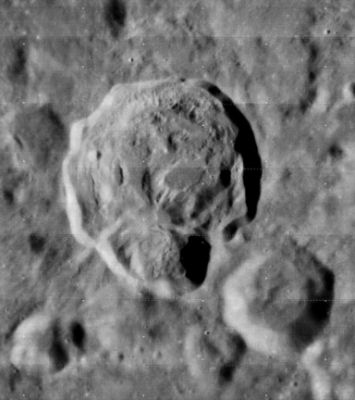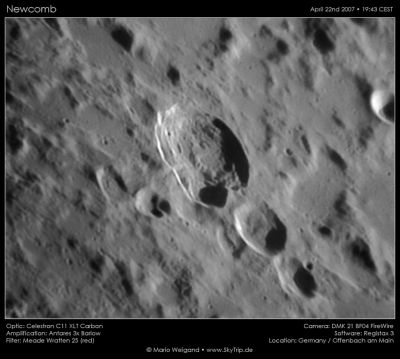Newcomb
Contents
[hide]Newcomb
|
Lat: 29.9°N, Long: 43.8°E, Diam: 41 km, Depth: 2.18 km, Rükl: 25, Eratosthenian | |
Images
LPOD Photo Gallery Lunar Orbiter Images Apollo Images
Newcomb is also detectable near the central part of the curved horizon in Apollo 17's oblique north-looking Fairchild camera frame AS17-M-0931. How much north-northeastern officially named lunar formations were captured in this frame?
Research: Danny Caes
Maps
(LAC zone 43B1) LAC map Geologic map
Description
Description: Elger
(IAU Directions) NEWCOMB.--The most prominent of a group of formations standing in the midst of the Haemus Mountains. Its crest is nearly 12,000 feet above the floor, on which there are some hills. THIS IS A MISTAKE! Newcomb is in the Taurus Mtns, not the Haemus. CAW Oct 2013
Description: Wikipedia
Additional Information
- Depth data from Kurt Fisher database
- Arthur, 1974: 2.18 km
- Westfall, 2000: 2.18 km
- Viscardy, 1985: 2.18 km
- Cherrington, 1969: 2.77 km
- Central peak composition: GNTA1 & GNTA2 (Tompkins & Pieters, 1999)
- Central peak height is 1.0 km Sekiguchi, 1972. - fatastronomer
Nomenclature
- Named for Simon Newcomb (March 12, 1835 – July 11, 1909), a Canadian-born American astronomer and mathematician. He was the distinguished director of the Nautical Almanac Office, which eventually became part of the United States Naval Observatory, and was the first Bruce Medalist of the Astronomical Society of the Pacific, where extensive links to information about him can be found.
- As noted in Mary Blagg's Collated List, where this feature is Catalog number 311, the name Newcomb appeared in Neison, 1876, although Julius Schmidt later called the same feature Bunsen.
- The name Newcomb was adopted in the original IAU nomenclature of Named Lunar Formations. Schmidt's name "Bunsen" was not used for any lunar feature at that time.
LPOD Articles
Bibliography
Certain Newcombs in the Sourcebook Project (William R. Corliss)
Something to investigate:
- A certain Professor Newcomb is mentioned in the article The Midnight Illumination above the Northern Horizon near the time of the Summer Solstice (E.E.Barnard, Astrophysical Journal, 1906), see pages 346-347 in Mysterious Universe, a handbook of astronomical anomalies (William R. Corliss, The Sourcebook Project, 1979).
- Another Newcomb (also a Professor Newcomb) is mentioned in the article On Some Objections to the Reality of Prof. Lowell's Canal System of Mars (A.M.Antoniadi, Journal of the British Astronomical Association, 1910), see page 384 in Mysterious Universe.
- One more Newcomb is mentioned in the article White Spot on Saturn (W.F.Denning, Scientific American, 1903), see page 486 in Mysterious Universe.
Were these three Newcombs perhaps one and the same person? - DannyCaes Mar 27, 2015

